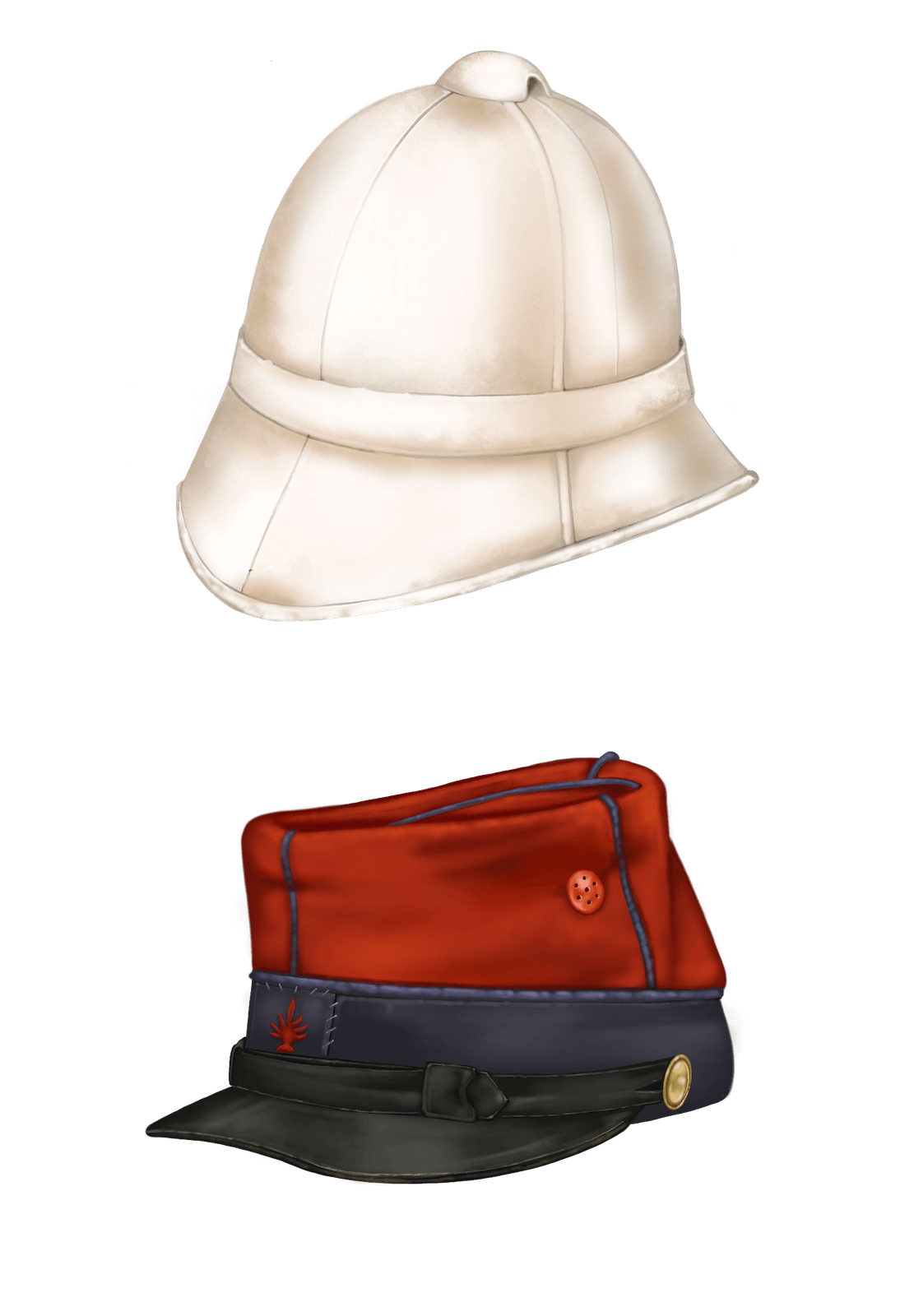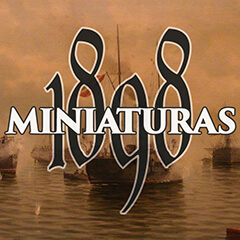French Foreign Legion uniform c. 1900
1898 Miniaturas

Illustrated guide to the iconic uniform of the French Foreign Legion in North Africa, c. 1900. Artwork by Pepe Rando. Click on the different elements to access their description.
French Foreign Legion légionnaire uniform

French légionnaire, c. 1900
The most characteristic elements of the uniform of the French Foreign Legion in North Africa are undoubtedly the capote (greatcoat) and the covered kepi. The capote represented here, M1897 (the differences with respect to the previous model, of 1872, are minimal), is blue, very vivid at the time of delivery, but quickly faded to an iron gray tone. Since 1884, the former grenade has been replaced on the collar by a patch in the color of the cape with the number of the regiment (1 or 2) in red. On the shoulders, the shoulder strap was usually worn rolled up in the loop of the epaulettes, which were not dressed in the field. Two rows of six buttons fasten the capote on the chest and one button on each cuff (two on the M1872), while the skirt is buttoned at the back, to facilitate the freedom of the legs during the march. Around his waist he wears a dark sky blue sash, authorized since 1882 (although in use previously), which functioned as a supporting body-belt. In the field, the red trousers were replaced by a white ones (in the illustration, M1879), which was normally dressed with the hem folded or tucked into the ankle boots or gaiters, and the kepi was always worn with a white cover that, especially in operations in the Sud-Oranais, could include a neck flap, in the same piece or in a separate piece. On full marching order, the soldier’s equipment, consisting of a haversack (musette), canteen, knapsack and weapons (to be described below) exceeded 22 kg. From 1868 French Army regulation prescribed moustaches, while the beard, which some veterans proudly wore long, was quite common, especially on campaign.

Kepi
The kepi M1884 was similar to that of the Line Infantry, except that instead of the regiment number, it carried the Legion’s seven-flame grenade. In addition to the ubiquitous covered kepi, in North Africa the Legion also used different models of pith helmets (casque colonial) made of cork, white with khaki covers or later, khaki.

Shirt
At the time, two models of shirts coexisted, one with buttons all the way down and a pullover with buttons only up to the chest. Both could have the collar buttoned in the center, or shifted to the right, and were supplied in different shades of white or light gray. In the absence of another uniform garment, the rank chevron was shown by a buttoned patch on the chest, which responded to the same code that we can see on the sleeves illustration (in this case, two red bands of a corporal).

Insignia of rank
French Foreign Legion non-commissioned officers and privates wore a series of insignia of rank on the sleeves of their uniform. Until 1887, seniority was indicated by an inverted V-shaped red chevron at shoulder height for every five years of service (which was equivalent to each re-enlistment). After that, it was replaced by a red cuff piping (red and gold for sergeants), although the previous system continued in use until 1904. The rank was indicated by a diagonal stripe above the cuff: one red stripe, 1st class soldier; two red stripes, corporal; a gold stripe, sergeant. Finally, a red buglehorn in the upper left sleeve denotes a marksmanship award.

Bugler
Buglers wore a white lace with blue and red diamonds on the jacket’s collar and cuffs. In the capote, this lace was worn around the collar, although below the patch where they carried the regiment number, which partially covers it. The trumpet cords also bore the colors of France.
French Foreign Legion officer’s uniform

French Foreign Legion officer’s uniform
The appearance of the officers varied ostensibly throughout the period due to changes in regulations, and the commissioning of the garments to private tailors who could alter their design. On the right, we see a M1893 blue officer’s tunic; on the left, a khaki (or white) coat with pockets, which follows the regulations of the Colonial Troops of 1901. In both cases, the insignia of rank are: on both sides of the collar, a flaming grenade with the regimental number; on the shoulders, a golden loop to fix the epaulettes, which are not worn in the field. On the cuffs, a removable gold-on-black chevron denoting rank: one band, sous-lieutenant; two bands, lieutenant; three bands, captain. A silver band with red piping in the center denoted the rank of adjudant. The regulation kepi, M1883, also bears the bands of the rank in gold (adjudant in silver). On campaign, the kepi was worn covered, or it was replaced by custom made white flannel model, or by a white or khaki pith helmet, which in the case of the officers carried the grenade with the regimental number.
Armament

Lebel Rifle M1888/93
The regulation weapon of the French Foreign Legion was the Lebel M1888/93 8mm repeating rifle, 130cm long and 4.4kg weight, with a capacity for ten rounds that used smokeless powder. The needle bayonet, prone to bending, measured 64 cm and was housed in a metal sheath that hung from the belt.
Equipment

Knapsack
The M1877/79 knapsack (havresac) was made of waterproof canvas on a wooden frame. An essential element of the “full marching order” for the eventful life in the field, it served to carry a heavy load of rations, ammunition, blanket, clothing, footwear, cutlery, a cleaning kit, personal belongings, etc. On top of the knapsack was carried le paquetage: the blue veste and the red pants, wrapped in a spare shirt and a towel. Over both, a section of the tent canvas (six sections buttoned together to form a tent) and their respective poles. Above, the individual messtin (gamelle). In addition, different field utensils were distributed among the men in the squad, such as the cooking pan (grande gamelle) or the 10-litre water can (marmite de campament) represented here, bundles of firewood, etc. The individual load of of each legionnaire could amount up to 40 kg.

Y-straps
The introduction of the Lebel rifle was accompanied by the introduction of a Y-straps, M1892. From the belt hung three M1888 cartridge pouches, two at the front and one at the back, with capacity for 24 rounds each, and the bayonet sheath.

Water canteen
The basic equipment of the légionnaire, called “light field equipment”, was completed with a canvas haversack (musette), in which the soldier carried rations for a day, ammunition, tobacco and personal effects, and a canteen (bidon) of two liters (not necessarily water), lined with a cloth cover of old capotes, which was accompanied by a mug. The strap of the canteen was worn underneath the Y-straps to prevent the soldier from drinking except at the stops established for it.

Footwear
The white canvas gaiters M1867 that accompanied the traditional low shoes became obsolete with the introduction of the ankle boots M1881 (brodequins napolitaines), although they can still be seen in photographs from as late as 1907. However, it is much more common to see the legionaries in the field with their trousers loose, tied at the ankle or stuffed into improvised gaiters made of greatcoat fabric with leather reinforcements.
© of the illustrations Pepe Rando
Recommended readings
- Brunon, J., Manue, G.-R. (1958): Le Livre D’Or de la Légion Étrangère (1831-1955). Paris-Limoges-Nancy: Charles-Lavauzelle & Cie.
- Windrow, M. (2010): The French Foreign Legion 1872-1914. Men-at-Arms n.º 461. Oxford: Osprey Publishing.
- Windrow, M. (2011): French Foreign Légionnaire 1890-1914. Warrior n.º 157. Oxford: Osprey Publishing.



